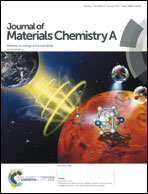Lithium bis(trifluoromethanesulfonyl)imide assisted dual-functional separator coating materials based on covalent organic frameworks for high-performance lithium–selenium sulfide batteries†
Abstract
The low transmission rate of lithium ions and the shuttling effect caused by soluble intermediate polysulfide/polyselenide ionic species have greatly limited the performance of Li–SeS2 batteries. In this work, we demonstrate that a separator coating material based on covalent-organic frameworks (COFs), TPB-DMTP-COF, can effectively resolve these issues. It is found that the TPB-DMTP-COF material can selectively adsorb lithium bis(trifluoromethanesulfonyl)imide (LiTFSI) species in the electrolyte through the formation of hydrogen bonding of C–H⋯F and O⋯Li. The accumulation of LiTFSI in the channels of TPB-DMTP-COF leads to a narrower pore size of the material and enhanced transportation of lithium ions in Li–SeS2 cells when the material is used as the separator coating. As a consequence, outstanding performance in terms of energy storage and stability was achieved in the Li–SeS2 battery using the TPB-DMTP-COF separator coating with a specific capacity of 844.6 mA h g−1 at 0.5C and a SeS2 loading of 2 mg cm−2. Even at a higher SeS2 loading of 4 mg cm−2, the cell demonstrated a specific capacity of 684 mA h g−1 at 1C. After 800 cycles, 416.3 mA h g−1 was still retained with a capacity decay rate of only 0.05% per cycle. This work sheds light on a new strategy toward high performance Li–SeS2 batteries by using COF based functional separator coating materials.



 Please wait while we load your content...
Please wait while we load your content...